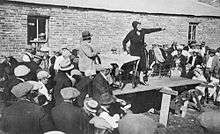Estevan riot
| Estevan Riot | |||
|---|---|---|---|
|
RCMP officers during the Estevan Riot | |||
| Date | September 29, 1931 | ||
| Location | Estevan, Saskatchewan, Canada | ||
| Caused by | Labor unrest from coal miners | ||
| Goals | Improved wages and working conditions | ||
| Methods | Protest march | ||
| Parties to the civil conflict | |||
|
| |||
| Casualties | |||
| Death(s) | 3 | ||

The Estevan riot, also known as the Black Tuesday Riot, was a confrontation between the Royal Canadian Mounted Police and striking coal miners from nearby Bienfait, Saskatchewan which took place in Estevan, Saskatchewan on September 29, 1931. The miners had been on strike since September 7, 1931 hoping to improve their wages and working conditions.
Background
Mine work in the region was seasonal and during the rest of the year, between April and August, miners would work in the fields as a way to supplement wages before returning to the mines. However, the droughts in the prairies and the overall economic situation in Canada made this impossible. This led to an increasing number of men looking for work in the mines, permitting mining companies to choose who they would hire.[1]
Furthermore, according to the Royal Commission investigating the strike, miners in Saskatchewan made half as much as their counterparts in Alberta and British Columbia.[2] Most miners and their families lived within company housing, where Annie Barylik, the sixteen-year-old daughter of a miner at Bienfait Mines described conditions as:
One bedroom, two beds in there, dining room, no beds in there, kitchen, one bed, and eleven in the family...I think we need a bigger place than that. When it is raining the rain comes in the kitchen. There is only one ply of paper, cardboard paper nailed to about two-inch wood board...It is all coming down and cracked...When the weather is frosty, when you wake up in the morning you cannot walk on the floor because it is all full of snow, right around the room.[3]
The miners were represented at the bargaining table by the local of the Mine Workers' Union of Canada (MWUC) They had been organized by the Communist Party of Canada's trade union umbrella, the Workers Unity League.
Riot
Several hundred assembled in Estevan with their families to parade through the city in order to draw attention to their strike. The RCMP confronted them and attempted to block and break up the procession. Police violence broke out and the police opened fire on the strikers, killing three of them. Many strikers were wounded and arrested.
Annie Buller, working with the Workers' Unity League, spoke in Estevan in support of the striking workers. Following the riot, Buller was charged and sentenced to one year of hard labour, to be completed at the Battleford Jail, and a $500 fine.[4]
Resolution
Following a meeting with Royal Commission Counsel, members of both parties signed the following agreement.
We, the mine operators and employees in conference at the court-house Estevan, this sixth day of October, 1931, hereby agree that the mines be opened immediately and the men return to work on following conditions, viz.:
(1) That this be considered a temporary arrangement pending the findings of the Wylie Royal Commission and the possible drafting of a working agreement between the operators and the men.
(2) That committees of employees for each mine be a recognized organization in each mine.
(3) That the provisions of the Mines Act be observed in relation to check-weighers.
(4) That all water in the roadways and working face be removed by the company and that such places be kept as dry as possible.
(5) That the terms of any schedule or agreement finally reached between the operators and the men be made retroactive to the date of re-commencement of work by them.
(6) That there shall be no victimization or discrimination against men on account of the strike, particularly in reference to men on the payrolls as at September 7 last.
(7) That contract men be employed on an eight-hour basis, face to face, and the company men work nine hours a day.
(8) That because of working conditions in the various mines. the removal of slack and questions of overweight be left to negotiations between the operators and the committees of employees.[5]
Legacy
The event remains controversial to this day in Estevan. The three striking miners who were killed have the inscription "murdered by RCMP" on their headstone, and locals have alternately erased and restored these words up to the present day.[6] The Saskatchewan Federation of Labour has created a plaque memorializing the strikers.
Popular culture
The Riot was depicted in the controversial documentary Prairie Giant: the Tommy Douglas Story, although Douglas was not actually present.
See also
References
- ↑ "On Strike: Chapter 2 (part 1)". 2007-05-21. Retrieved 2017-10-27.
- ↑ Hanson, Stanley Duane (1971). The Estevan Strike and Riot. University of Saskatchewan, Regina. p. 50.
- ↑ [null] Wylie Commission, Proceedings, vol. 3, pp. 77-78.
- ↑ Deshaw, Garnet. "Buller, Annie (1896-1973)". The Encyclopedia of Saskatchewan.
- ↑ "Preliminary Agreement," p. 9.
- ↑ Hewitt, Steven (1997-01-01). "September 1931: A Re-interpretation of the Royal Canadian Mounted Police's Handling of the 1931 Estevan Strike and Riot". Labour / Le Travail. 39 (0): 159–178. ISSN 1911-4842.
External links
- Regina Leader Post Article on the Riot from the following day
- A Personal Editorial on the Riot including Photographs of Commemorative Plaques
- 1931 strike in Estevan Mercury
- A Paper discussing the Strike and Subsequent Riot
- Review of Bienfait: The Saskatchewan Miners' Struggle of '31 (Stephen L. Endicott, Toronto: University of Toronto Press 2002) by Lorne Brown, Labour/Le Travail 52 (Fall 2003).
- Estevan Coal Strike, Encyclopedia of Saskatchewan
- Estevan Strike and Riot, 1931, Oral History Centre (University of Winnipeg)